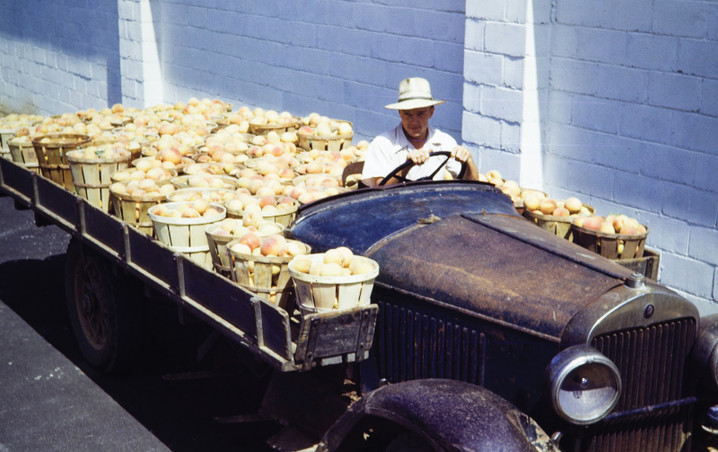Posted by Jeff Pauls on 16th Jul 2018
Where Did Peach Cobbler Come From?
What’s your opinion of peach cobbler? Are you a fan? It may depend on the recipe you made or how it turned out. It might be just a matter of taste. Some recipes are sweeter than others, while some recipes are less gooey.
Cobbler is such a simple recipe. And like many simple recipes, it’s quite old. It’s been subject to many alterations through the decades.
If you’ve read some of the other posts in this blog (April, May and June), then you know fruit is prominent in our nation’s history. For example, in April’s post, we learned just how prolific peach trees have been--even before Pennsylvania was settled. From the beginning, fresh fruit has been common in the diet of every people group inhabiting this land. Two fruits, blueberries and strawberries, were enjoyed by native tribes long before exploring Europeans came by sail. “When Europeans arrived, the Native Americans had already developed new varieties of corn, beans, and squashes and had an abundant supply of nutritious food.” As British colonists established themselves here, cider, preserves, and any number of recipes calling for juicy, fresh fruit became quite common.
However, fresh fruit was harder to access further west, as it had not been homesteaded like the eastern seaboard had. Any fruit that westbound travelers ate was in a preserved form, either dried or canned. The rigors of a trapper’s life or that of pioneers seeking to establish homesteads further and further west, did not allow for the type of prepared foods coming from kitchens outfitted with numerous utensils or the latest cooking stoves. The family garden or established orchards weren’t just outside the tent flap.
Speaking of stoves, a word about life on the trail and food preparation is in order. As to cookware, whatever you had room for or had fashioned, was used over an open flame. Even though it was a heavier item, the Dutch Oven was often the choice here. Its ultimate utility out weighed its weight ;). In fact, even as early as Lewis and Clark, two members of the expedition, Ordway and Whitehouse, mention the Dutch Oven as an essential piece of travel cookware. Given that you had to carry or somehow cart anything you needed for your survival, economy of space, not to mention weight, was paramount. One had to be very particular about what one brought. Although, as histories of the Oregon Trail attest, many people learned this the hard way. The many items unceremoniously left at Fort Laramie--heirloom furniture, stoves, food--are evidence of the severe winnowing of comfort made necessary by life on the trail. So, as to items that made the list of bare essentials, if you had baking soda, a Dutch Oven, and a can of peaches, cobbler could definitely be on the menu.
Which finally brings us to the recipes! While the recipes below don’t need to be baked in a Dutch Oven, they certainly could be. And remember, the first recipe might not be exactly what you’ve come to expect when you eat dessert, but imagine the hardship of a 5-6 month trek across the plains and it might be an unexpected delight in an otherwise arduous and dusty existence.
Enjoy! And be sure to shop Kauffman’s for any of the ingredients listed. And, if you have our book, Faith, Family, and Fruit, it has a number of great peach recipes in it. If you don’t have a copy yet, order it here.
Other sites referenced for this article:
- A Brief History of Peach Cobbler in USA Today
- A Brief History of Cobbler by Joe Pastry
- A Complete History of Dutch Ovens (Might I add, this one’s quite fascinating.)
- Cast Iron Cooking Colonized and Settled America
- History of Traditional Tribal Foods
This first cobbler is probably pretty close to what pioneers on the trail tasted.
- 1 lg. can peaches, drain most of syrup
- Bisquick, fill half of dish with Bisquick
- 1 stick of butter and 1/4 stick
- 3/4 c. hot water
- 1 c. sugar
- Cinnamon to taste
Use a 9 x 3/4 x 9 3/4 x 2 inch pan. Mix Bisquick, butter and hot water together. Add peaches. Add 1/4 stick more butter (cut and put slices on top). Add cinnamon and sugar. Bake at 350 degrees for 35 minutes or until golden brown. May add chopped nuts if desired. Add vanilla ice cream on top when warm if desired.
This second cobbler is probably closer to what you might expect a cobbler should taste like.
Yield: Serves 4
Active time: 20 min
Total time: 45 min
Ingredients:
- 6 large peaches, cut into thin wedges
- 1/4 cup sugar
- 1 tablespoon fresh lemon juice
- 1 teaspoon cornstarch
- For biscuit topping
- 1 cup all-purpose flour
- 1/2 cup sugar
- 1 teaspoon baking powder
- 1/2 teaspoon salt
- 3/4 stick cold unsalted butter, cut into small pieces
- 1/4 cup boiling water
Preparation:
Cook peaches:
Preheat oven to 425°F.
Toss peaches with sugar, lemon juice, and cornstarch in a 2-qt. nonreactive baking dish and bake in middle of oven 10 minutes.
Make topping while peaches bake:
Stir together flour, sugar, baking powder, and salt. Blend in butter with your fingertips or a pastry blender until mixture resembles coarse meal. Stir in water until just combined.
Remove peaches from oven and drop spoonfuls of topping over them. Bake in middle of oven until topping is golden, about 25 minutes. (Topping will spread as it bakes.)

